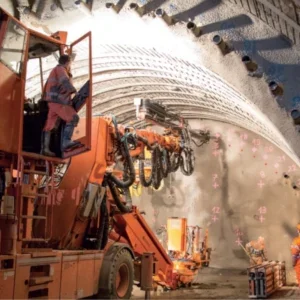The Tunnelling Association of Canada (TAC), has published its annual regional report. The four regional directors take a look at the country’s current marketplace for tunnelling and underground construction, as well as taking a look back at industry milestones from the past year.
Ontario
Upcoming tunnelling projects in Ontario include the Fairbanks- Silverthorn Trunk Storm Sewer System and the City of Toronto is currently prequalifying Design-Build Contractors. The project consists of 2.2km of approximately 4m diameter EPB tunnelling, 540m of 1.65m diameter microtunnelling, along with shafts, open cut and other work.
The City of Ottawa has CSO Tunnels in progress, possibly coming out to tender the fourth quarter of this year.
In Windsor the Detroit River Rail Tunnel has completed the EA and the project is progressing. A tender date is currently not known. Halton Region, Zone 1 interconnecting watermain tunnel, part of mid-Halton wastewater scheme, has completed prequalification and continues until November 2014.
For the Twinning of the West Trunk Sewer, Contract No. 2, City of Mississauga, Region of Peel, the project is scheduled to tender during this year.
Design is completed for the Upper Centennial Parkway, for the City of Hamilton, and the project should be out to tender in the third to fourth quarter of this year
Recently awarded projects in Ontario include construction of RR#25, Halton Region – Awarded to Varcon Construction, and tunnelling will be performed by C+M McNally.
The Hanlan Feedermain, Contract 1 – has been awarded to McNally Construction, with construction underway. And the Hanlan Feedermain, Contract 3 – has been awarded to Southland-Technicore JV, with construction underway.
McNally Construction has also secured the contract for Twinning of the West Trunk Sewer, Contract # 1, and construction is underway.
The Eglinton Scarborough Crosstown Light Rail project, East twin tunnel contract was awarded to an Aecon-Dragados JV. Construction has commenced, but no tunnelling yet.
There is a very active Microtunnelling market in Ontario with projects from Kingston to Guelph. There are many large microtunnel project pre-qualifications that have closed and contractors are waiting for the projects to hit the streets, such as Twinning of Etobicoke creek (under Pearson airport) and the Rebecca Trunk Wastewater project. It’s still a very hot and active market place in Ontario, with plenty of activity that will continue into next year.
In general news Brian Garrod is retiring after an extensive career at Hatch Mott MacDonald, and is also stepping down from the Ontario TAC director position. Nominations for the new Ontario TAC director were held and the outcome is yet to be announced.
CAT Tunnelling has sold assets and intellectual property to LOVSUN of China, which hopes to start operations in October.
The Ontario Chapter is planning to hold a tunnelling workshop in Ontario in 2015, please watch for more details to come.
TAC Ontario holds its general meetings the last Thursday of every month at Moxie, all active members are welcome to attend. Keep a look-out for our regularly scheduled events and our yearend social.
Walter Trisi, VP director of Ontario TAC Trisi is general manager and vice president of CRS Tunnelling Canada
Quebec
On the Romaine-3 Hydro-electrical complex (395 MW), a drill and blast project, there were four contracts: the river diversion tunnel, the powerhouse, the spillway-intake-dams and the pressure tunnel. The river diversion D-shaped tunnel is 100 per cent completed, it length is around 351m, and is 13m wide and 12m high. The rock plugs were blasted and removed in May and the tunnel is presently in operation.
The excavations for the surface powerhouse, the spillway and the intake are ongoing and almost completed with the final benches still left to be removed. Foundation treatment have begun for the dam (95m high) and the dyke (33m high). The pressure tunnel is a D-shaped excavation and the work is just beginning with the starting portal excavation advanced of 20m. The tunnel is 1,675m long, and is 18m wide and 12m high. The maximum head is 119m and the steel penstock is planned to be 60m long.
The McGill North East Utility Tunnel, construction of a new tunnel associated with its hospital operations at the McGill University’s downtown Montreal campus, is currently underway using the drill and blast method. The tunnel passes directly beneath and adjacent to buildings that house sensitive facilities and equipment, research laboratories, medical treatment rooms and patients that are undergoing or recovering from various medical procedures and surgeries. It will house new utilities to replace those currently in use that have reached the end of their service lives as well as address overcrowding of pipe material within the existing tunnels.
In order to maintain all University activities during construction, the contract documents call for drill and blast excavation in accordance with certain constraints related to peak particle velocities, blast air-overpressure and audible blast noise measured at selected locations. The need to operate within these limits had a direct impact on blast design elements including overall powder factors, charge weights per delay, and round lengths. On the other hand, the contract documents allow the opportunity to conduct test blasts, which may permit the relaxation of blast design criteria.
The tunnel will be approximately 202m in length and 3m in width, with one access shaft and three riser shafts.
The construction of McGill North East Utility Tunnel that is currently underway using drill and blast excavation required careful planning and execution to minimise disruption to the University operations that house sensitive medical and research equipment as well as patients. The design approach used to include a cautious but feasible controlled blasting base-case drowned from extensive experience to address the need to limit vibration, air-overpressure and noise is being implemented and is proven to be effective. It first allowed realistic baseline that were used during the bidding process and it also provides the contractor with flexibility to adjust its means and methods while staying within specified monitoring limits. An effective risk assessment and risk management process allowed identifying key risks and implementing risk control measures that are being implemented during construction activities. The project teams include program management by WSP, tunnel design and CM services by HMM, and the contractor is Neilson with BBA for the contractor blasting specialist.
A hard rock TBM tunnel for a water main is being built in Montreal. The project involves the excavation of a 3m diameter water main tunnel to reach to existing Rosemont reservoir of 227,000m3. The tunnel is 3.98km long and is excavated within the generally hard Trenton limestone of Ordovicien age. An open Robbins TBM is being used for the job and the tunnel is planned to be completed within 10 months. The bedrock is generally of good to excellent quality but it crosses several intrusions structures such as dykes and sills related with the Mont-Royal intrusion of Cretaceous age. Foraction is the sub-contractor of Les Entreprises Michaudville inc., the general contractor, with an awarded contract of CAD 73M (USD 66.67M). The project begun in May with the shaft excavation and is schedule to last a total of around 28 months from the beginning of the shaft excavation to the final pipe installation and valve chamber construction.
Additional reporting: Mylène Sansoucy, Hydro-Québec; Jean Habimana, HMM
Alberta and Praries
Alberta tunnellers have been active during this past year, thanks to a booming economy and an ever growing population in Calgary and Edmonton. The City of Calgary is in the process of completing a feasibility study for a 5km-long, 10m-diameter tunnel, which is being considered as a flood bypass structure from the Glenmore Reservoir to the Bow River. The tunnel would help mitigate the impact of future floods like the one in June 2013, and is one of three alternatives being considered. The City is also proceeding with investigations for numerous 2-3m diameter sewer and water tunnels up to 1.8km long, which are part of the Nose Creek sanitary upgrades, and relocations associated with the upcoming construction of the Southwest Ring Road. The trenchless crossing of the Bow River in Bowness is being tendered at the time of writing, and involves twin 1050mm-diameter tunnels, 200m long each; anticipated to be constructed using slurry microtunnelling.
In Edmonton, in addition to the usual abundance of small diameter municipal tunnels, the CAD 1.8bn (USD 11.65M), 13km-long LRT Valley Line is proceeding as a P3 project, and will include construction of twin 400m-long tunnels on the north side of the North Saskatchewan River crossing. Five teams responded to the City’s RFQ released in April and three have been shortlisted to submit a bid to design, build, operate, maintain and partially finance the project.
The shortlisted teams are TransEd Partners (almost a dozen companies, including Bechtel, EllisDon and Bombardier Transportation Canada), Moving YEG (made up of 10 rms that include ACS Infrastructure Canada, Hochtief PPP Solutions North America, and Stantec) and River City Transit (composed of about eight firms including SNC-Lavalin, Kiewit and Alstom). Final proposals are expected in the fall of 2015 with the successful team selected by the end of 2015. Major construction is expected to begin in 2016.
British Columbia
The tunnelling industry is active in BC, with a number of planned, ongoing and completed projects in Greater Vancouver and other regions of the province.
Metro Vancouver’s Seymour-Capilano Twin Tunnels Completion Project is currently under construction. These 7.1km long, 3.8m diameter twin tunnels have been constructed between Metro Vancouver’s Capilano Reservoir and the Seymour Filtration Plant. Tunnelling was carried out by the Seymour-Cap Partnership (joint venture of Aecon, JF Shea and Frontier Kemper), who were awarded a contract in April 2009 to complete the tunnels.
Both Tunnels were complete by November 2010 and the two shaft excavations (by raise bore) were completed in April 2011. Final shotcrete lining in portions of the Tunnels and steel liner installation is 100 per cent complete as of August. Surface steel pipe installation is underway and the Project is scheduled to be completed this autumn.
The Port Mann Water Supply Tunnel project is a water supply tunnel connecting the Greater Vancouver suburbs of Coquitlam and Surrey, which is being undertaken by Metro Vancouver. The project consists of two slurry wall shafts, each approximately 60m deep and located on either side of the Fraser River, connected with a 1km-long, 3.5m-diameter tunnel. Excavation and construction of the permanent structural lining of the south and north shafts are now complete. Excavation of the tunnel is being carried out using a CAT EPB TBM, and at the time of the magazine going to press, approximately one half of the tunnelling has been completed. Construction is being undertaken by the McNally- Aecon Joint Venture.
The Second Narrows Water Supply Tunnel Project is a proposed 1.1km-long water supply tunnel connecting the Greater Vancouver suburbs of North Vancouver and Burnaby, which is also being undertaken by Metro Vancouver. The approximately 5.7m-diameter tunnel will be driven through variable soils and bedrock beneath Burrard Inlet.
Preliminary design of the project is currently underway, with construction planned to commence in 2017.
The Annacis Main No 5 Water Tunnel is a proposed water supply tunnel beneath the Fraser River connecting the Greater Vancouver suburbs of New Westminster and Surrey. Conceptual design is currently underway for the project. Construction is planned to commence in 2018.
The Evergreen Line Rapid Transit Project will be an 11km extension to Greater Vancouver’s rapid transit system. The project includes a 2km-long, 10m-diameter bored tunnel. The design-build-finance contract was awarded to EGRT Construction and the tunneling work is being conducted by SNC-SELI Joint Venture (SSJV). The tunnel is being excavated with a CAT EPB TBM and is 12 per cent complete as of early August. Tunnel boring is expected to be completed early 2015.
BC is also currently experiencing an increase in activity in hydroelectric project development. AltaGas recently completed the 195 MW Forrest Kerr Hydro Project on the Iskut River in northern BC. The project consists of an extensive amount of underground work, including over 5,000m of access, tailrace and power tunnels. The project also includes an underground powerhouse cavern (144m long, 17m span, 26m height). Tunnel construction was carried out by Procon Mining and Tunnelling of Burnaby, BC. The project is now in service.
AltaGas is also constructing the 66 MW McLymont Creek Hydro Project, which is located approximately 10km downstream of the Forrest Kerr Project. This project includes an intake, surface powerhouse and a 2.7km-long Power Tunnel. Tunnel excavation commenced in Q2 2013, with tunnel excavation being carried out by Procon Mining and Tunnelling. The project is scheduled for completion in mid 2015.
The proposed John Hart Generating Station Replacement Project is owned by BC Hydro and is located in Campbell River, on Vancouver Island. The CAD 1bn (USD 0.91bn) project, for which the principal contract was awarded earlier this year to inPower BC (SNC-Lavalin), includes the construction of a 2.1km-long rock tunnel, an underground powerhouse, and associated shafts and access tunnels. Underground construction is scheduled to commence this fall.
Innergex Renewable Energy is constructing the Upper Lillooet Hydroelectric Project approximately 72km northwest of Pemberton BC. The project includes two facilities, Upper Lillooet River Hydroelectric Facility (HEF) and Boulder Creek Hydroelectric Facility. The Upper Lillooet River HEF is a 81.4 MW plant consisting of over 2,500m of power tunnel and approximately 1,600m of 3.6m-diameter steel penstock. The tunnel is constructed by drill and blast methods and is 5.5m high x 6m wide. Tunnel construction is being carried out by CRTEBC (S.E.N.C.) of Quebec.
Tunnel excavation work began in August, with overall project completion scheduled for mid 2016.
The Boulder Creek HEF is a 25.3 MW plant being constructed on a tributary of the Lillooet River. This tunnel is approximately 2,900m long and is also being constructed by drill and blast methods, and is 3.5m wide x 4.5m high. The tunnel is being constructed by the same contractor, CRTEBC. Tunnel excavation began in June, with project completion also intended for 2016.
A third and separate project being constructed by Innergex is the Big Silver Hydroelectric Project, located approximately 40km north of Harrison Hot Springs in BC. The Big Silver tunnel is 5.5m high and 6m wide, with a total length of 1,800m.
Tunnelling for this project is scheduled to begin later this year with the equipment and crews from the Boulder Creek HEF project mobilizing to Big Silver during their winter shut down period. In addition, tunnels are associated with a number of planned hydroelectric projects and planned mining projects in BC.






